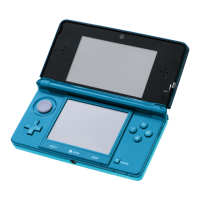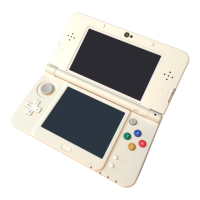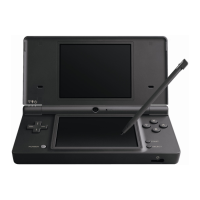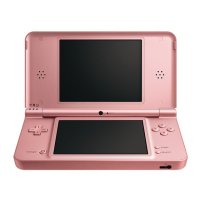Do you have a question about the Nintendo 3DS XL and is the answer not in the manual?
Describes the visual indicators of a successful StreetPass data transfer.
Provides guidelines for safe and comfortable use of the 3D feature.
Warns about potential seizure risks when playing video games.
Advises on preventing eye strain and motion sickness during system use.
Warns about potential injuries from repetitive motions while using the system.
Details precautions to prevent battery leakage and potential hazards.
Details safety precautions for using the system in specific locations like airports.
Identifies and describes key buttons, LEDs, and input devices on the system.
Explains the function of audio jacks, microphones, and speakers.
Details external parts like battery cover, slots, and camera modules.
Explains basic touch and slide gestures used with the stylus.
Guides users on how to calibrate the touch screen for accurate input.
Provides step-by-step instructions for charging the system using the AC adapter.
Introduces the optional charging cradle for convenient recharging.
Explains how to activate Sleep Mode to conserve power while keeping certain functions active.
Outlines the initial setup steps required before the system can be used.
Details how to use the on-screen keyboards for character input.
Explains the meaning of the power LED indicators and factors affecting battery life.
Provides guidance on optimal viewing distance and angle for 3D images.
Explains how to use the 3D depth slider to customize the 3D effect.
Offers advice and warnings regarding potential eye strain and discomfort from 3D viewing.
Covers the process of inserting, removing, and managing SD cards in the system.
Explains the function of the write-protection switch on SD cards.
Provides important guidelines and limitations when copying software to an SD card.
Explains how to scroll through software icons and adjust display settings.
Describes the icons indicating Internet and StreetPass connection status.
Details how software icons are displayed and how to launch applications.
Covers how to suspend applications to return to the HOME Menu or close them.
Explains how to change screen brightness and enable power-saving features.
Guides users on how to access and view electronic manuals for software titles.
Details how to create folders to organize software icons on the HOME Menu.
Covers renaming, deleting folders, and icons that cannot be moved.
Explains how to insert Game Cards and launch software from them.
Describes the Pan European Game Information age rating categories and content descriptors.
Instructs on how to properly close or suspend software titles.
Explains how to obtain software via SpotPass, Nintendo eShop, or demo versions.
Lists important considerations and limitations for downloading software.
Covers the steps to launch downloaded or pre-installed software titles.
Explains how to write, edit, and save notes using the Game Notes application.
Describes how to change the screen display while using Game Notes.
Guides users on how to add friends locally or via the internet.
Explains how to view other friends' cards and edit your own.
Covers managing friend notifications and deleting friends.
Details the procedures for registering friends via local wireless or internet connection.
Explains the two stages of friend registration and what happens at each step.
Guides on how to customize your friend card with messages and favorite titles.
Explains how to see when friends are online and join their games.
Provides instructions on how to join a friend's multiplayer game session.
Covers managing friend status notifications and deleting contacts.
Explains the different types of notifications and when they are received.
Guides on how to view received notifications and disable specific types.
Covers using the touch screen for navigation, touch links, and toolbar functions.
Explains how to bookmark pages and manage browser history.
Advises on using Parental Controls to restrict internet access.
Details how to use the cameras to capture 3D photos and videos.
Offers advice on achieving optimal results when taking 3D photos and videos.
Highlights features like camera modes and video options for creative capture.
Explains how to view captured photos and videos, including slideshows and video editing tools.
Covers how to play music stored on an SD card and adjust audio settings.
Details how to record short audio clips and edit them.
Guides on creating personalized Mii characters using photos or from scratch.
Explains how to register Mii characters and receive them from friends or other systems.
Introduces games that can be played with Mii characters met via StreetPass.
Explains how to download software like Virtual Console and DSiWare titles.
Lists important terms and conditions for using the Nintendo eShop service.
Describes how to use AR Cards with the system's cameras for augmented reality gaming.
Guides on how to play the game by taking photos and moving the system.
Covers tracking daily steps, play time, and viewing software usage history.
Explains how to play multiplayer games with a single game copy.
Covers configuring internet connection, Wi-Fi, and other network-related settings.
Guides on setting restrictions for software, online features, and system usage.
Explains how to check, delete, and manage downloaded software, save data, and system memory.
Covers various system configurations like profile, date/time, sound, and language.
Provides instructions on connecting the system to the internet wirelessly.
Lists the necessary components for establishing an internet connection.
Details the process of setting up an internet connection using the AOSS feature.
Guides on connecting to a network using Wi-Fi Protected Setup.
Explains how to find and connect to available wireless access points.
Covers entering security keys and performing connection tests for network setup.
Explains signal strength icons and compatible security types for network connections.
Details how to set up internet connections specifically for Nintendo DS software.
Provides guidance on troubleshooting and resolving error codes during internet setup or play.
Covers configuring automatic software downloads and system information sharing.
Lists the various system functions and content that can be restricted using Parental Controls.
Guides on setting up a PIN, secret question, and configuring specific restriction options.
Explains how to temporarily remove or permanently disable Parental Controls.
Details the process for recovering a forgotten PIN or secret question answer.
Explains how to check, delete, and manage downloaded software, save data, and system memory.
Explains how to view StreetPass-compatible software and deactivate the feature.
Provides a quick reference to various system settings like Profile, Date & Time, and Sound.
Guides on manually calibrating the outer cameras for better 3D image quality.
Details the process of transferring data from older systems to the Nintendo 3DS XL.
Explains how to transfer data between Nintendo 3DS and 3DS XL systems.
Lists important considerations when transferring Nintendo DSiWare and its save data.
Highlights caveats related to transferring downloaded software and save data.
Guides on how to update the system software and applications for new features.
Explains how to format the system memory, erasing all data to restore factory settings.
Provides instructions on how to safely replace the system's rechargeable battery pack.
Offers guidance on the proper disposal of the battery pack according to regulations.
Offers solutions for issues where the system freezes or becomes unresponsive.
Addresses problems with viewing 3D images, including double vision or difficulty seeing them.
Provides troubleshooting steps for unresponsive touch screens or inaccurate Circle Pad input.
Offers solutions for problems related to sound output through speakers or headphones.
Addresses issues with the microphone not working or voice recognition not responding.
Troubleshoots problems with step counting and SD card recognition.
Solves problems related to camera response, color issues, and facial recognition.
Helps resolve problems with playing audio files using the Nintendo 3DS Sound application.
Addresses problems with AR card recognition and using Download Play.
Provides information on environmentally sound disposal of the product and its components.
Details technical specifications for the system, battery pack, and stylus.
Outlines the terms and conditions of the 12-month consumer warranty for hardware.
Lists specific conditions and situations not covered by the warranty.
Provides instructions on how to submit a warranty claim to Nintendo Customer Support.
Covers the terms of use and restrictions for the system's built-in operating software.
Provides contact details for Nintendo Customer Support in the UK and Ireland.
Outlines the terms and conditions of the 12-month consumer warranty for hardware.
Lists specific conditions and situations not covered by the warranty.
Provides instructions on how to submit a warranty claim to Nintendo Service Centre.
Covers the terms of use and restrictions for the system's built-in operating software.
Provides contact details for Nintendo Service Centre and hotline in South Africa.
Lists patent and design registration numbers related to the product's technology.
Describes the visual indicators of a successful StreetPass data transfer.
Provides guidelines for safe and comfortable use of the 3D feature.
Warns about potential seizure risks when playing video games.
Advises on preventing eye strain and motion sickness during system use.
Warns about potential injuries from repetitive motions while using the system.
Details precautions to prevent battery leakage and potential hazards.
Details safety precautions for using the system in specific locations like airports.
Identifies and describes key buttons, LEDs, and input devices on the system.
Explains the function of audio jacks, microphones, and speakers.
Details external parts like battery cover, slots, and camera modules.
Explains basic touch and slide gestures used with the stylus.
Guides users on how to calibrate the touch screen for accurate input.
Provides step-by-step instructions for charging the system using the AC adapter.
Introduces the optional charging cradle for convenient recharging.
Explains how to activate Sleep Mode to conserve power while keeping certain functions active.
Outlines the initial setup steps required before the system can be used.
Details how to use the on-screen keyboards for character input.
Explains the meaning of the power LED indicators and factors affecting battery life.
Provides guidance on optimal viewing distance and angle for 3D images.
Explains how to use the 3D depth slider to customize the 3D effect.
Offers advice and warnings regarding potential eye strain and discomfort from 3D viewing.
Covers the process of inserting, removing, and managing SD cards in the system.
Explains the function of the write-protection switch on SD cards.
Provides important guidelines and limitations when copying software to an SD card.
Explains how to scroll through software icons and adjust display settings.
Describes the icons indicating Internet and StreetPass connection status.
Details how software icons are displayed and how to launch applications.
Covers how to suspend applications to return to the HOME Menu or close them.
Explains how to change screen brightness and enable power-saving features.
Guides users on how to access and view electronic manuals for software titles.
Details how to create folders to organize software icons on the HOME Menu.
Covers renaming, deleting folders, and icons that cannot be moved.
Explains how to insert Game Cards and launch software from them.
Describes the Pan European Game Information age rating categories and content descriptors.
Instructs on how to properly close or suspend software titles.
Explains how to obtain software via SpotPass, Nintendo eShop, or demo versions.
Lists important considerations and limitations for downloading software.
Covers the steps to launch downloaded or pre-installed software titles.
Explains how to write, edit, and save notes using the Game Notes application.
Describes how to change the screen display while using Game Notes.
Guides users on how to add friends locally or via the internet.
Explains how to view other friends' cards and edit your own.
Covers managing friend notifications and deleting friends.
Details the procedures for registering friends via local wireless or internet connection.
Explains the two stages of friend registration and what happens at each step.
Guides on how to customize your friend card with messages and favorite titles.
Explains how to see when friends are online and join their games.
Provides instructions on how to join a friend's multiplayer game session.
Covers managing friend status notifications and deleting contacts.
Explains the different types of notifications and when they are received.
Guides on how to view received notifications and disable specific types.
Covers using the touch screen for navigation, touch links, and toolbar functions.
Explains how to bookmark pages and manage browser history.
Advises on using Parental Controls to restrict internet access.
Details how to use the cameras to capture 3D photos and videos.
Offers advice on achieving optimal results when taking 3D photos and videos.
Highlights features like camera modes and video options for creative capture.
Explains how to view captured photos and videos, including slideshows and video editing tools.
Covers how to play music stored on an SD card and adjust audio settings.
Details how to record short audio clips and edit them.
Guides on creating personalized Mii characters using photos or from scratch.
Explains how to register Mii characters and receive them from friends or other systems.
Introduces games that can be played with Mii characters met via StreetPass.
Explains how to download software like Virtual Console and DSiWare titles.
Lists important terms and conditions for using the Nintendo eShop service.
Describes how to use AR Cards with the system's cameras for augmented reality gaming.
Guides on how to play the game by taking photos and moving the system.
Covers tracking daily steps, play time, and viewing software usage history.
Explains how to play multiplayer games with a single game copy.
Covers configuring internet connection, Wi-Fi, and other network-related settings.
Guides on setting restrictions for software, online features, and system usage.
Explains how to check, delete, and manage downloaded software, save data, and system memory.
Covers various system configurations like profile, date/time, sound, and language.
Provides instructions on connecting the system to the internet wirelessly.
Lists the necessary components for establishing an internet connection.
Details the process of setting up an internet connection using the AOSS feature.
Guides on connecting to a network using Wi-Fi Protected Setup.
Explains how to find and connect to available wireless access points.
Covers entering security keys and performing connection tests for network setup.
Explains signal strength icons and compatible security types for network connections.
Details how to set up internet connections specifically for Nintendo DS software.
Provides guidance on troubleshooting and resolving error codes during internet setup or play.
Covers configuring automatic software downloads and system information sharing.
Lists the various system functions and content that can be restricted using Parental Controls.
Guides on setting up a PIN, secret question, and configuring specific restriction options.
Explains how to temporarily remove or permanently disable Parental Controls.
Details the process for recovering a forgotten PIN or secret question answer.
Explains how to check, delete, and manage downloaded software, save data, and system memory.
Explains how to view StreetPass-compatible software and deactivate the feature.
Provides a quick reference to various system settings like Profile, Date & Time, and Sound.
Guides on manually calibrating the outer cameras for better 3D image quality.
Details the process of transferring data from older systems to the Nintendo 3DS XL.
Explains how to transfer data between Nintendo 3DS and 3DS XL systems.
Lists important considerations when transferring Nintendo DSiWare and its save data.
Highlights caveats related to transferring downloaded software and save data.
Guides on how to update the system software and applications for new features.
Explains how to format the system memory, erasing all data to restore factory settings.
Provides instructions on how to safely replace the system's rechargeable battery pack.
Offers guidance on the proper disposal of the battery pack according to regulations.
Offers solutions for issues where the system freezes or becomes unresponsive.
Addresses problems with viewing 3D images, including double vision or difficulty seeing them.
Provides troubleshooting steps for unresponsive touch screens or inaccurate Circle Pad input.
Offers solutions for problems related to sound output through speakers or headphones.
Addresses issues with the microphone not working or voice recognition not responding.
Troubleshoots problems with step counting and SD card recognition.
Solves problems related to camera response, color issues, and facial recognition.
Helps resolve problems with playing audio files using the Nintendo 3DS Sound application.
Addresses problems with AR card recognition and using Download Play.
Provides information on environmentally sound disposal of the product and its components.
Details technical specifications for the system, battery pack, and stylus.
Outlines the terms and conditions of the 12-month consumer warranty for hardware.
Lists specific conditions and situations not covered by the warranty.
Provides instructions on how to submit a warranty claim to Nintendo Customer Support.
Covers the terms of use and restrictions for the system's built-in operating software.
Provides contact details for Nintendo Customer Support in the UK and Ireland.
Outlines the terms and conditions of the 12-month consumer warranty for hardware.
Lists specific conditions and situations not covered by the warranty.
Provides instructions on how to submit a warranty claim to Nintendo Service Centre.
Covers the terms of use and restrictions for the system's built-in operating software.
Provides contact details for Nintendo Service Centre and hotline in South Africa.
Lists patent and design registration numbers related to the product's technology.
| Platform | Nintendo 3DS |
|---|---|
| Motion sensor | Yes |
| Product color | Blue |
| Main camera resolution | 640 x 480 pixels |
| Number of built-in speakers | 2 |
| Compatible memory cards | SD |
| Display diagonal | 4.88 \ |
| Display resolution | 800 x 240 pixels |
| Second display diagonal | 4.18 \ |
| Display number of colors | 16.78 million colors |
| Second display resolution | 320 x 240 pixels |
| Wi-Fi standards | 802.11b, 802.11g |
| Security algorithms | WPA, WPA2 |
| Depth | 93 mm |
|---|---|
| Width | 156 mm |
| Height | 22 mm |
| Weight | 336 g |












